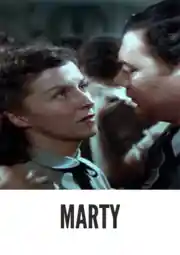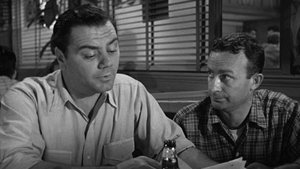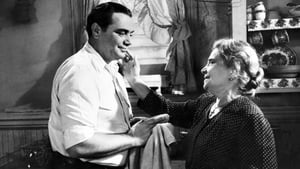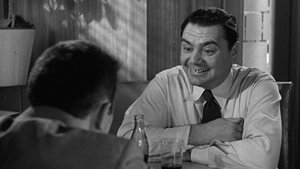Contact: [email protected]
Video Sources 0 Views

Synopsis
[ez-toc]




Introduction
In the dynamic realm of cinema, the art of restoration has taken center stage, offering audiences a chance to rediscover timeless classics in a new light. Among these revived gems stands “Marty Colorized 1955,” a bold venture that infuses Ernest Borgnine’s poignant performance with a fresh burst of color. This article embarks on a journey into the heart of Marty, exploring its transformation and the broader implications of colorization on old films.
Read Media File Transfer Agreement: Terms and Conditions
Read FAQ
Brief Overview of Marty Colorized 1955
Originally released in 1955 and directed by Delbert Mann, “Marty” unfolds as a heartfelt exploration of love and societal expectations. Now, decades later, the film undergoes a transformative process, embracing the vibrant hues of colorization. As we delve into this cinematic venture, we confront the age-old debate surrounding colorized movies and ponder the future of restored films.
Significance of Colorized Movies and the Debate Around Them
The decision to colorize a classic film is a contentious one, stirring debates among purists who argue for the preservation of the original black-and-white aesthetic. However, proponents of colorization contend that it breathes new life into old movies, making them more accessible to contemporary audiences. The article aims to navigate this debate and shed light on the evolving landscape of film restoration.
The Purpose of the Article: Exploring the Impact of Colorization on Old Films and Making Predictions for the Future
As we embark on this exploration of Marty Colorized 1955, our goal is twofold: to analyze the specific changes brought about by colorization and to speculate on the broader implications for the future of restored films. What does Marty’s colorful reimagining signify for other classics, and how will technological advancements shape the way we perceive cinematic heritage?
Understanding Marty Colorized 1955
Review of Marty (1955) and Its Journey to Being Colorized
“Marty Colorized” (1955) emerged as a groundbreaking film, winning the Palme d’Or at the Cannes Film Festival and the Academy Award for Best Picture. The narrative revolves around Marty Piletti, a middle-aged butcher played by Ernest Borgnine, navigating the complexities of love in a 1950s Bronx neighborhood. The film’s raw authenticity and Borgnine’s powerful portrayal earned it a lasting place in cinematic history.
In the recent colorized iteration, the decision to add a spectrum of colors to Marty’s world prompts a reevaluation of its visual and emotional impact. This bold move aims to introduce the film to new audiences while inviting old fans to experience it in a fresh context.
Synopsis of the Original Film and Key Changes Made in the Colorized Version
The heart of Marty lies in its simplicity and sincerity. The narrative unfolds as Marty, an ordinary man, navigates the pressures of societal expectations and self-discovery. The colorized version maintains the core of the story but introduces subtle visual enhancements, allowing audiences to perceive the Bronx streets and Marty’s emotional journey through a different lens.
Notable Performances in Marty Colorized: Ernest Borgnine and Betsy Blair
Central to the success of Marty is the exceptional performance by Ernest Borgnine, who breathes life into the character with authenticity and vulnerability. Betsy Blair, as Clara, Marty’s love interest, complements Borgnine’s portrayal with grace and nuance. In the colorized version, their chemistry takes on a new vibrancy, adding layers to the emotional resonance of the film.
Director Delbert Mann’s Vision for the Movie
Delbert Mann’s directorial vision played a pivotal role in Marty’s success. His commitment to portraying real, relatable characters and capturing the essence of the 1950s working-class experience contributed to the film’s enduring appeal. The colorized version maintains Mann’s original vision while introducing a contemporary aesthetic that aligns with modern viewers’ expectations.
Exploring Paddy Chayefsky’s Screenplay Adaptation from Teleplay to Film
Paddy Chayefsky’s screenplay, adapted from his own teleplay, forms the narrative backbone of Marty. Chayefsky’s ability to infuse the script with authenticity and genuine emotion elevates the film beyond its simple premise. The colorized version accentuates the nuances of Chayefsky’s writing, offering a new perspective on the interplay between dialogue and visual aesthetics.
The Love Story in Marty Colorized 1955 and Its Relevance Today
Analysis of the Central Romance in Marty and How It Resonates with Audiences
At the heart of Marty is a poignant love story that transcends time. Marty and Clara’s connection, born out of shared loneliness and societal pressures, strikes a chord with audiences. The colorized version amplifies the emotional resonance of their relationship, providing a contemporary lens through which viewers can connect with the characters.
Examining the Influence of Social Pressures on the Protagonist’s Relationship
Set against the backdrop of the conservative 1950s, Marty grapples with societal expectations and the stigma associated with being single at a certain age. The colorized version emphasizes the social dynamics of the era, offering audiences a nuanced exploration of how external pressures shape Marty’s decisions and the trajectory of his love story.
Portrayal of 1950s Values and Ideals in the Film’s Narrative
Marty serves as a time capsule, preserving the values and ideals of 1950s America. The colorized version allows contemporary viewers to visually immerse themselves in this bygone era, experiencing firsthand the cultural nuances that define Marty’s world. The juxtaposition of 1950s values with a modern aesthetic prompts reflection on societal changes over the decades.
Impact on American Cinema: Marty Colorized as a Classic Film
Legacy of Marty in the History of American Cinema
“Marty Colorized” holds a special place in the history of American cinema, standing as a beacon of realism in an era dominated by glossy Hollywood productions. Its success paved the way for a shift in narrative focus, encouraging filmmakers to explore the complexities of everyday life. The colorized version not only pays homage to Marty’s legacy but also introduces it to a new generation of cinephiles.
Positioning the Film Among Other Noteworthy Productions of Its Time
The 1950s witnessed the emergence of films that delved into the human experience with depth and sincerity. Marty, alongside classics like “On the Waterfront” and “12 Angry Men,” contributed to a cinematic renaissance. In its colorized form, Marty aligns itself with the visual aesthetics of
its time, allowing contemporary audiences to appreciate its narrative richness through a lens that resonates with modern sensibilities.
Contrasting Marty’s Realism with the Spectacle of Hollywood Blockbusters
In an era where Hollywood often gravitates towards larger-than-life spectacles, Marty Colorized stands as a testament to the power of authenticity and relatability. The film’s colorized version continues to carve its niche by providing a stark contrast to the bombastic productions that dominate today’s cinematic landscape. It serves as a reminder that storytelling doesn’t always require grandeur; sometimes, the most profound tales unfold in the simplicity of everyday life.
The Colorization Controversy: Examining the Process and Its Effects
Comprehensive Look at the Art and Science Behind Colorizing Black-and-White Movies
Colorization, as a process, involves adding color to monochrome films, breathing new life into the visuals. The technology has evolved significantly since its inception, allowing for more nuanced and precise color grading. In the case of Marty Colorized 1955, the colorization process is executed with meticulous care, preserving the original cinematography while enhancing the overall visual appeal.
Pros and Cons of Altering the Original Visual Aesthetic through Color Enhancement
As with any artistic endeavor, colorization brings both advantages and criticisms. On the positive side, it can make classic films more visually engaging and relatable to contemporary audiences. The addition of color can accentuate details, providing a more immersive experience. However, purists argue that colorization compromises the director’s original vision and the historical authenticity of black-and-white cinema. Striking a balance between these perspectives becomes crucial in evaluating the success of Marty’s colorized rendition.
Behind the Scenes of Marty Colorized 1955: Paddy Chayefsky’s Script and Burt Lancaster’s Influence
Role of Screenwriter Paddy Chayefsky in Shaping the Story of Marty Colorized
Paddy Chayefsky, a luminary in the world of screenwriting, played a pivotal role in adapting Marty from teleplay to film. His ability to capture the essence of human relationships and infuse them with genuine emotion laid the foundation for the film’s success. The colorized version respects Chayefsky’s original intent, ensuring that the screenplay’s depth and emotional impact remain integral to Marty’s narrative.
Examining Burt Lancaster’s Dual Role as Lead Actor and Producer on the Film
Burt Lancaster’s involvement in Marty Colorized goes beyond his compelling performance as the film’s producer. His influence permeates the project, contributing to the nuanced storytelling and the careful selection of creative elements. In the colorized version, Lancaster’s commitment to Marty’s authenticity resonates, as the film retains its emotional depth while embracing a contemporary visual aesthetic.
Reception and Criticism of Marty Colorized 1955
Initial Reviews of the Colorized Version: Was It a Worthy Update to the Original?
As Marty steps into the world of color, critical reception becomes a pivotal aspect of its journey. Initial reviews offer insights into how audiences perceive the colorized iteration. Evaluating whether Marty Colorized 1955 is a worthy update requires considering factors such as the fidelity to the original narrative, the effectiveness of colorization in enhancing the viewing experience, and the overall reception among both existing fans and new audiences.
Considering Audience Reactions to Marty in Both Its Monochrome and Colorized Formats
The film’s reception extends beyond critical reviews to the audience’s emotional connection. Marty Colorized 1955 aims to bridge generational gaps, inviting new viewers to appreciate a classic in a format that aligns with contemporary expectations. Understanding how audiences respond to Marty in both its monochrome and colorized formats provides valuable insights into the film’s enduring appeal and its ability to resonate across diverse audiences.
Looking Beyond Marty: The Future Landscape of Restored Films
Predictions for the Role of Restoration Techniques in Preserving Cinematic Heritage
As technology advances, the landscape of film restoration continues to evolve. Predicting the future role of restoration techniques involves considering advancements in artificial intelligence, higher resolution formats, and innovative colorization methods. Marty Colorized 1955 serves as a precursor to a broader trend where classic films may find new life through cutting-edge restoration technologies.
Balancing Between Authenticity and Modern Audience Preferences in the Restoring Process
The delicate balance between authenticity and catering to modern audience preferences becomes a central theme in the future of restored films. Marty’s colorization navigates this balance by preserving the film’s emotional core while adapting its visual presentation. As restoration techniques evolve, filmmakers and restoration artists face the challenge of maintaining historical accuracy while making classic films more accessible to contemporary viewers.
Embracing Diversity in Film Restoration: Beyond Colorization
Exploring Non-Color Related Methods to Enhance Diversity in Restored Films
While colorization aims to breathe new life into old films, embracing diversity in restoration goes beyond altering hues. Exploring non-color-related methods involves addressing aspects such as audio enhancement, preservation of lost footage, and the representation of diverse cultures and perspectives. As the film industry strives for inclusivity, restoration becomes an opportunity to highlight a broader range of voices and narratives.
Preserving the Integrity of Original Works: Guidelines for Responsible Film Restoration
The Importance of Maintaining Historical Accuracy and Artistic Intent in the Restoring Process
Responsible film restoration requires adherence to ethical considerations that prioritize historical accuracy and artistic intent. Preserving the integrity of original works involves meticulous research, collaboration with archival experts, and a commitment to presenting films as they were intended by their creators. Marty Colorized 1955 sets an example by embracing colorization without compromising the essence of the original film.
Conclusion
As we reflect on Marty Colorized 1955, the film emerges as a pivotal example of the evolving landscape of restored films. Its journey from black-and-white simplicity to a colorized visual feast offers a glimpse into the potential future of cinematic restoration. The debate surrounding colorization persists, but Marty’s successful transition opens the door to broader discussions about the preservation of cinematic heritage.
Encouraging a respectful and informed discourse on the value of colorization in film restoration becomes paramount. Marty Colorized 1955 invites audiences to appreciate the nuanced interplay between tradition and innovation, between the cherished past and the possibilities of the future. In its colorful rebirth, Marty continues to captivate hearts, reminding us that the magic of storytelling persists, transcending the boundaries of time and color. As we navigate the ever-expanding sea of cinematic offerings, Marty beckons, ready to weave its charm for generations to come.















